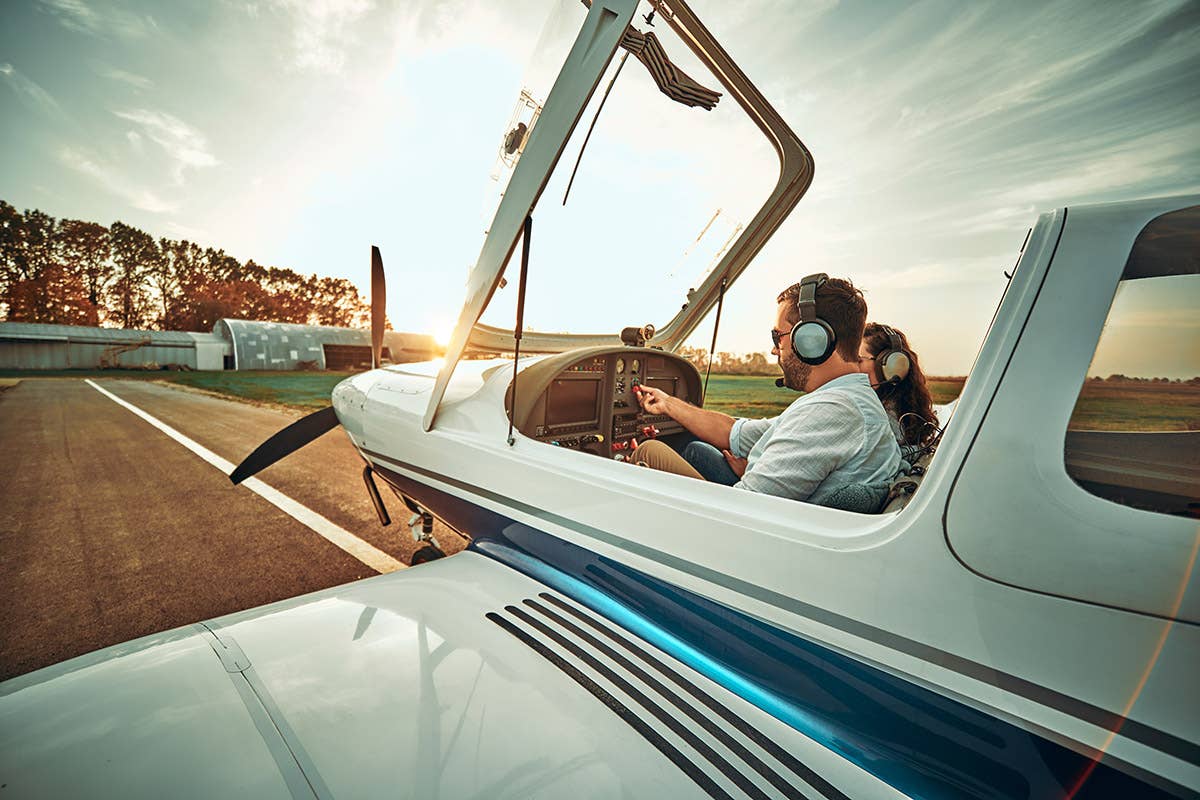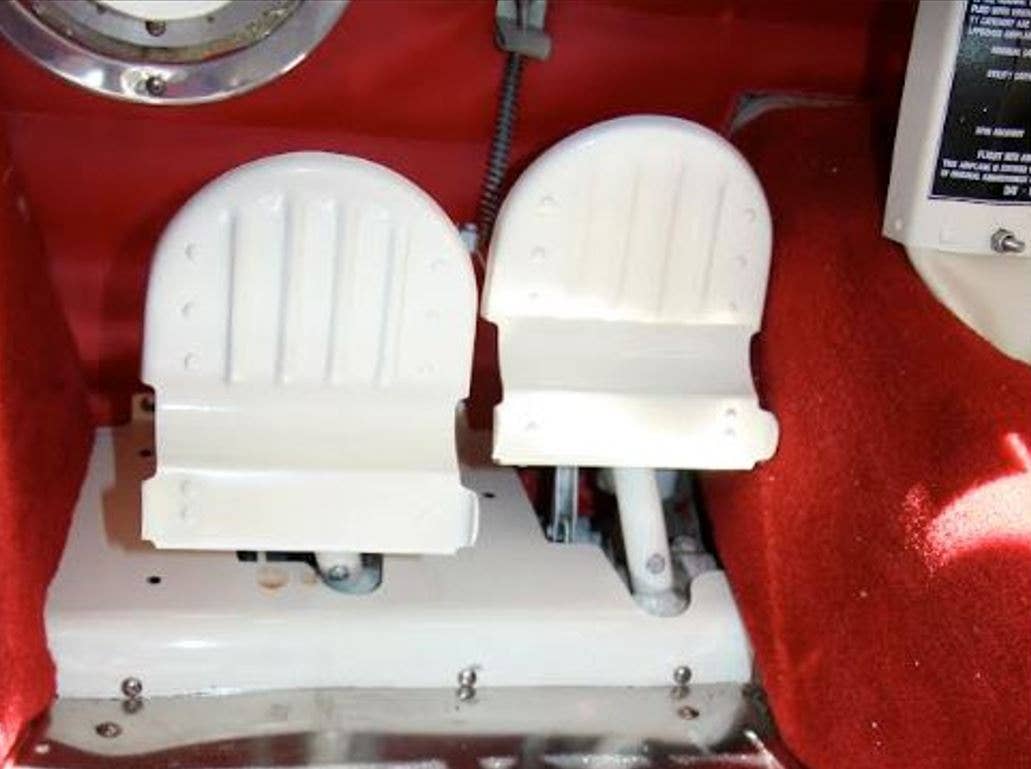Takeoff Stalls and How to Prevent Them
Solid understanding of the fundamentals coupled and practical experience from quality training are essential.

During takeoff, an aircraft is in a vulnerable place. Stall/spin accidents are among the most common fatal accidents in general aviation. [Credit: Clare Nicholas]
It’s a beautiful day, and you’ve decided to take advantage of the flying club Cessna 172 to take your friend on a sightseeing flight.
You did your weight-and-balance planning properly, ensuring that you were in the weight and center-of-gravity (CG) limits. Your preflight revealed no potential surprises. Now you’re lined up on the runway, your pretakeoff checks completed.
You release the brakes and move the throttle forward smoothly, just how you were taught. Your eyes scan from outside to inside, ensuring the temperatures and pressures are in the green and the airspeed is alive.
You rotate smoothly, but as the nose pitches, you feel yourself sliding backward. You instinctively grip the control column harder and pull it back with you. Your brain briefly registers that something has gone seriously wrong. The last thing you hear is the shrill shriek of the stall warning.
I wish I could say that something like this is extreme and highly unlikely. But unfortunately it’s not.
I should know. I almost became a statistic of a loss of control and stall during takeoff. I was flying with a friend, and it was very much like the scenario described above, only we were in a taildragger. I noticed something wasn’t right as soon as the tail came up on the takeoff. I went to rotate, and my seat started to slide backward.
Luckily, my friend, who was also a pilot, noticed the movement out of the corner of his eye. As I went sliding back, taking the control column with me, he pushed forward, hard, preventing a violent pitch. We almost went off the runway, but thanks to his quick reaction, we managed to get airborne and climb away safely.
I couldn’t understand how it happened. I checked that my seat was securely latched twice before we took off. Upon landing, we discovered that a stop on the seat rail was not correctly fitted. In fact, it was not fitted at all. It should have prevented the seat from moving more than about 5 inches should the latch mechanism fail. Needless to say, checking those stops is now part of my preflight.
Have you heard that over 28 percent of fatal stall/spin accidents occur during takeoff?
Why Do Aircraft Stall During Takeoff?
During takeoff, an aircraft is in a vulnerable place. With flaps and gear out, you’re creating a lot of drag, and it doesn’t take a large external force to upset the flight path. It’s also a critical phase of flight, requiring a lot of concentration. Even the smallest distraction can set a chain of events in motion.
If you have read previous articles on stalling, you probably know why aircraft stall (it’s all about critical angle of attack, not airspeed), how to recognize it, and have a better idea of how to recover and avoid it. If not, here’s a summary.
Since the beginning of 2024 alone, I have come across at least five GA accidents that resulted in a stall on takeoff or the go-around. There are also many accidents involving commercial aircraft that spring to mind. They all share a common theme—pilot decision.
Aeronautical decision-making (ADM) plays a big role in risk mitigation, and a quick Google search of stalls during the takeoff and approach indicate that the decisions of the pilot are what brought on that situation. This highlights the need for good quality training that isn’t just about the flying but also includes the decision-making process required for every flight.
Contributing Factors
Weight and Performance
Have you done your weight-and-balance calculations? Are you below the maximum all up weight (MAUQ) of the aircraft? Have you considered the day’s conditions? Just because the aircraft has four seats and a MAUW of 2,300 pounds doesn’t mean you should load it to the hilt.
A heavier aircraft requires more runway to get airborne. Have you done a performance calculation for the runway you’re operating from? Have you considered the density altitude, runway slope, headwind, and tailwind?
If you haven’t, you might find yourself halfway down the runway and still below flying speed. There’s a fence at the end of the runway. You glance inside, noticing your speed is still 10 knots below VR. You look outside again, and the fence is uncomfortably close.
You have no choice. You pull back hard on the control column. The aircraft unwillingly unsticks from the ground but doesn’t climb. You pull back more because you have to clear the fence, and the stall horn sings its song.
Elevator Trim Position
Ever wondered why training aircraft have a neutral trim position? Have you seen airliners that have a green trim range indicator on their instrumentation? Light aircraft have quite a small CG envelope, so a neutral trim position is sufficient as long as the aircraft is loaded within the envelope.
But larger aircraft have a much wider CG range, and the trim is calculated before every takeoff.
The above photo is of the Embraer 135 multifunction display (MFD). Can you see the pitch-trim indicator? It’s not in an obvious place, and you could miss that it is set well out of the green range.
Normally, taking off with it in this position will result in an aural warning as you advance the thrust levers. However, should the aural warning not work (maybe a circuit breaker was pulled), the pilot could easily overlook the trim setting, leaving themselves open to overrotation and a potential stall after takeoff.
Taking off with the elevator trim in the wrong position could result in overrotation if it’s set too far nose up or underrotation, requiring the pilot to use excessive force and possibly overcorrect to over-rotation, if set too far nose down.
Another consideration is during the approach to land. In light aircraft, it is a good idea to have the elevator trim in the neutral position when landing. Depending on the aircraft and conditions, this might make the controls feel a little heavier on the approach, but it will protect you in the event of a go-around.
Applying power to go around with the trim too far in the nose-up position will result in a large upward pitch, which could result in a stall if you’re not expecting it.
Center of Gravity
Training aircraft are designed to have a forward CG as it makes them more stable. This doesn’t mean that loading heavy bags or people in the aircraft won’t shift the CG aft. An aft CG could result in less, or even no, pitch down of the nose during a stall.
During takeoff, it could result in premature rotation before flying speed is achieved, leading to very little or no climb. To achieve more lift at low speed, we can increase the angle of attack, but this gets us dangerously close to the critical AOA.
While not that relevant to training aircraft, another consideration is load shift. Do you remember the Boeing 747 that crashed in Kabul, Afghanistan, in 2013? Cargo wasn’t secured correctly and shifted aft on takeoff.
Load shift becomes a consideration in any aircraft carrying cargo. Flying cargo in the GA8 Airvan, Cessna Grand Caravan, and Daher Kodiak, I was always acutely aware of correctly loading and securing the contents.
Aircraft Not Correctly Configured for Takeoff
In 1987, a Northwest Airlines MD-82 crashed after takeoff. The subsequent investigation indicated that the flaps and slats were not correctly configured for takeoff, resulting in a longer than normal takeoff run, reduced climb performance, and stall after getting airborne.
Investigation findings highlighted the improper use of checklists and SOP noncompliance to be contributing factors.
I recently came across an accident report involving a Cessna 172, which stalled during takeoff in 2022.
The pilot loaded the aircraft with two other adults and operated out of a runway at 4,900 feet elevation. The flight took place in the early morning, so it wasn’t too hot yet (68 degrees Fahrenheit).
Since the pilot was a holder of a commercial pilot license, it should have been an uneventful takeoff. Unfortunately, they decided that it was a good idea to strap the right-hand door of the aircraft to the wing strut to hold it open.
The increased drag resulted in a longer takeoff run, lack of climb performance, and subsequent stall.
Accidents like these highlight the importance of quality training to set the foundation for good airmanship and ADM.
Risks and Considerations
While the majority of stalls during takeoff can be avoided just by practicing good airmanship and proper planning, there are some scenarios that might be outside of your control. Ask your instructor and see what they think.
Engine Failure After Takeoff
Many articles have been written about the engine failure after takeoff (EFATO), followed by the “impossible turn.” I’m not going to get into that here. But a stall can be prevented following an EFATO by identifying a suitable landing place within 30 to 45 degrees either side of the aircraft nose and flying it down rather than attempting a turn back to the runway.
During your PPL training, you will be taught the pretakeoff safety briefing and touch checks, so that should something go wrong, you will instinctively react and recover. This is done to overcome the startle factor when things suddenly go awry, allowing us to instinctively do what we have been trained to do.
Birds
Where there is a runway, there will be birds. They are attracted to airfields and airports like bees to honey. No matter how well you scan the skies ahead, there is always a chance of birds crossing your flight path on takeoff.
What do you do?
For the most part, birds dive down to get out of the way. To create space, the logical thing for us to do is go up, right? Remember, we’re likely low, slow, and already at 5 to 10 degrees AOA for the climb, so pulling back on the control column is not the best idea.
Your best option is probably just to continue. If impact is imminent, you could duck down below the instrument panel should the birds go through the windscreen. Also consider that you may have engine trouble following the impact.
I’d rather deal with an engine failure than put myself into a low-level stall.
Downdrafts and Wind Shear
Common in the vicinity of thunderstorms, or mountainous areas, downdrafts can have you plummeting toward the earth at thousands of feet per minute. Consider delaying your departure until the storm has passed or until the winds have died down.
If you do find yourself caught in a downdraft, whether at altitude or close to the ground, don’t attempt to pitch to the heavens to outclimb it. You might just stall in the process.
Instead, don’t change the aircraft configuration, keep the wings level, add power, and do your best to fly out of it.
Stall Recovery During Takeoff
As you can see, stalls close to the ground should be avoided at all costs. But what should you do if you find yourself in that situation? A Google search doesn’t provide much information on recovery as most articles focus on prevention.
If the odds are stacked against you and you do find yourself stalled low to the ground, I can’t provide you with a one-size-fits-all recovery technique as there are too many variables involved.
Power-On Recovery Technique
1) Release back pressure to unload the wing. This needs to be just enough as releasing too much back pressure could result in a descent.
2) Simultaneously, smoothly apply full power. Anticipate the yaw and correct with rudder. Be aware that the aircraft will want to pitch toward the canopy, so you might need slight forward pressure on the control column to prevent it from overcorrecting.
3) Keep the wings level and the ball in the middle with rudder.
4) Once the aircraft is stable and you have a positive rate of climb, do the after-takeoff checks.
While this is the recovery procedure for minimum height loss, remember that you could still lose several hundred feet during the recovery maneuver.
Some might argue that if you are low, it might be best to keep the aircraft in the stall as you will likely impact the ground with minimal forward speed.
Personally, I would focus on keeping the wings level with rudder to prevent a low-level spin, aim to impact the ground as slowly as possible, and fly the aircraft as far into the crash as possible.
In Summary
Stalls close to the ground are rarely recoverable.
A correctly configured aircraft operated within its limits by a competent pilot shouldn’t get close to a stall. Prevention is better than cure, and a solid understanding of the fundamentals coupled with practical experience from quality training is essential to developing the skills required to keep you out of danger.
To become a safer pilot, I recommend more research of your own so that you can learn from the mistakes of others.

Subscribe to Our Newsletter
Get the latest FLYING stories delivered directly to your inbox






